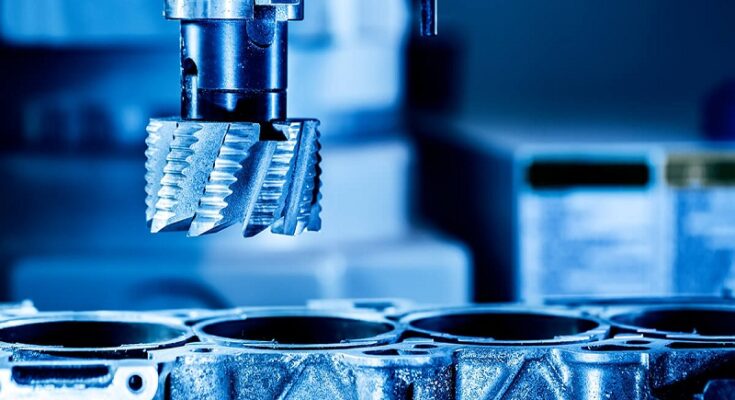introduction
Metal cutting tools are the backbone of modern manufacturing processes, enabling the creation of intricate components across various industries. From automotive to aerospace, from electronics to construction, metal cutting tools play a pivotal role in shaping raw materials into refined products. The world of metal cutting tools explores their types, applications, and innovative solutions that drive efficiency and precision in metalworking.
Understanding Metal Cutting Tools
Metal cutting tools encompass a wide array of instruments designed to shape, carve, and slice through metal materials with precision and accuracy. These tools come in various forms, each tailored to specific machining requirements.
- Drills: Used for creating holes in metal surfaces, drills come in different configurations such as twist drills, center drills, and spot drills. They rely on rotary motion to bore through metal.
- End Mills: These versatile tools are utilized for milling operations, including cutting, facing, and slotting. End mills feature cutting edges on their sides and tips, enabling them to perform diverse machining tasks.
- Turning Tools: Often employed in lathes, turning tools rotate a workpiece while a stationary cutting tool removes material to achieve desired shapes and dimensions.
- Milling Cutters: Milling cutters utilize rotary motion to remove material from a workpiece’s surface, producing flat or contoured features with high precision.
- Inserts and Blades: These are replaceable cutting elements embedded within tools such as drills, milling cutters, and turning tools. Inserts and blades enhance tool longevity and facilitate efficient machining operations.
Applications of Metal Cutting Tools
Metal cutting tools find applications across a broad spectrum of industries and manufacturing processes.
- Automotive Manufacturing: Metal cutting tools are integral to fabricating automotive components such as engine parts, chassis components, and transmission systems with precise tolerances and high durability.
- Aerospace Engineering: In the aerospace industry, metal cutting tools are utilized to manufacture aircraft components ranging from fuselage structures to turbine blades, ensuring compliance with stringent quality standards.
- Electronics Production: Metal cutting tools are indispensable in the production of electronic devices, facilitating the fabrication of intricate parts such as circuit boards, connectors, and heat sinks.
- Construction and Infrastructure: From structural steel fabrication to precision machining of building components, metal cutting tools play a vital role in constructing infrastructure projects with accuracy and efficiency.
- Medical Device Manufacturing: Metal cutting tools are employed in crafting medical implants, surgical instruments, and prosthetic devices, where precision and biocompatibility are paramount.
Challenges in Metal Cutting
Despite their versatility and effectiveness, metal cutting tools encounter several challenges during machining operations.
- Tool Wear: Continuous contact with metal surfaces leads to wear and degradation of cutting edges, reducing tool lifespan and compromising machining quality.
- Heat Generation: Friction between the tool and workpiece generates heat, which can cause thermal deformation, workpiece distortion, and premature tool failure if not effectively managed.
- Chip Formation: Proper chip evacuation is crucial to prevent chip buildup, which can interfere with machining processes, cause surface defects, and pose safety hazards.
- Surface Finish: Achieving the desired surface finish and dimensional accuracy requires meticulous tool selection, machining parameters optimization, and effective coolant application.
- Material Hardness: Machining materials with high hardness levels, such as hardened steels and exotic alloys, necessitates specialized cutting tools and cutting parameters to ensure efficiency and tool longevity.
Innovative Solutions in Metal Cutting
To address these challenges and enhance machining efficiency, manufacturers continually innovate metal cutting tools and machining techniques.
- Advanced Coatings: Cutting tool manufacturers apply specialized coatings such as titanium nitride (TiN), titanium aluminum nitride (TiAlN), and diamond-like carbon (DLC) to improve tool wear resistance, reduce friction, and enhance chip evacuation.
- High-Speed Machining: HSM techniques leverage high spindle speeds and feed rates to optimize material removal rates while maintaining surface quality and dimensional accuracy, particularly beneficial for intricate machining operations.
- Coolant Technologies: Advanced coolant systems, including through-tool coolant delivery and cryogenic cooling, effectively dissipate heat during machining, prolong tool life, and enhance chip evacuation, contributing to improved productivity and surface finish.
- Tool Material Innovation: The development of high-performance tool materials such as carbide, cermet, and cubic boron nitride (CBN) enables the machining of challenging materials with superior wear resistance, toughness, and thermal stability.
- Digitalization and Industry 4.0 Integration: Integration of metal cutting processes with digital technologies, including CNC machining, predictive analytics, and real-time monitoring, enables adaptive machining strategies, proactive tool maintenance, and optimization of machining parameters for enhanced productivity and quality control.
Addressing Sustainability in Metal Cutting
In addition to efficiency and precision, sustainability has become a crucial consideration in modern metal cutting operations. As industries strive to minimize environmental impact and optimize resource utilization, metal cutting tool solutions have introduced eco-friendly products to promote sustainability throughout the machining process.
- Recycling Programs: Many metal cutting tool manufacturers implement recycling programs for used tools and materials, reducing waste and conserving valuable resources. Scrap carbide, for example, can be recycled to produce new cutting tools, contributing to a closed-loop manufacturing cycle.
- Energy-Efficient Machining: Optimizing machining parameters such as cutting speeds, feeds, and depths of cut can significantly reduce energy consumption and greenhouse gas emissions associated with metal cutting operations. Implementing energy-efficient machining practices not only lowers production costs but also aligns with sustainability goals.
- Green Coating Technologies: Emerging coating technologies incorporate environmentally friendly materials and processes, reducing the environmental footprint of cutting tool manufacturing. Water-based coatings and low-emission deposition techniques minimize solvent usage and air pollutants, promoting eco-conscious manufacturing practices.
- Circular Economy Initiatives: Embracing a circular economy approach, metal cutting tool manufacturers focus on extending product lifespan, enhancing recyclability, and minimizing environmental impact throughout the product life cycle. Designing tools for disassembly, refurbishment, and reuse fosters a sustainable manufacturing ecosystem while reducing waste generation.
- Alternative Materials Research: Exploring alternative materials for cutting tool construction, such as sustainable composites and bio-based polymers, offers opportunities to reduce reliance on traditional metal alloys and mitigate environmental concerns associated with mining and processing raw materials.
Emerging Trends in Metal Cutting Technology
As technology continues to evolve, several emerging trends are shaping the future of metal cutting.
- Additive Manufacturing Integration: The integration of additive manufacturing (AM) techniques with traditional metal cutting processes enables hybrid manufacturing approaches, allowing for the creation of complex geometries, customized tooling, and on-demand production with unprecedented flexibility and efficiency.
- Artificial Intelligence and Machine Learning: Artificial intelligence (AI) and machine learning (ML) algorithms are revolutionizing metal cutting by enabling predictive maintenance, adaptive machining strategies, and real-time process optimization. AI-driven toolpath optimization algorithms minimize machining time and energy consumption while ensuring optimal surface finish and dimensional accuracy.
- Nanotechnology Applications: Nanotechnology advancements are driving the development of nanoscale cutting tools with superior wear resistance, reduced friction, and enhanced material removal capabilities. Nanocomposite coatings and nanostructured tool materials offer unprecedented performance improvements, enabling precision machining of advanced materials with nanoscale features.
Conclusion
Metal cutting tools represent the cornerstone of modern manufacturing, enabling the fabrication of intricate components across diverse industries. As technology advances and manufacturing demands evolve, the development of innovative metal cutting solutions continues to drive efficiency, precision, and competitiveness in the global marketplace. By leveraging cutting-edge technologies and embracing continuous improvement initiatives, manufacturers can unlock new possibilities in metalworking, paving the way for a future characterized by enhanced productivity, sustainability, and excellence in craftsmanship.




